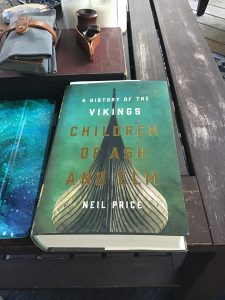
The Vikings are a people both familiar and unfamiliar to us. Familiar through all manner of popular representations on television (Vikings, The Last Kingdom, Norsemen), in the movies (The 13th Warrior, The Vikings, Outlander, Valhalla Rising), and fiction (The Hammer and the Cross, The Golden Wolf Saga).
But unfamiliar in terms of our knowing of their minds, how they understood themselves, and how they understood the worlds through which they moved. Worlds both seen and unseen. This is where Neil Price’s new history of the Vikings, Children of Ash and Elm, truly astonishes, opening an inner window into a people whose minds are in many ways deeply alien to our own.
As Price, distinguished professor and chair of archaeology at Uppsala University, Sweden, explains in an early chapter:
[V]ery different worlds were being built inside the Norse mind. Here is another distinction between appearance and reality, between the surface and what it conceals. From the problematic medieval written sources, and occasional mentions in Eddic and skaldic poetry, emerges one of the most remarkable aspects of the Vikings: the fourfold division of being and an extremely complex notion of what might loosely be called the soul.
This fourfold division begins with their hamr – literally their shell or shape – what you would see if you met a Viking on the street. But this shape, or physical appearance, was not fixed. It could alter, allowing shape-changing into a wolf or bear, or other bird or beast. Not everyone could do this, it wasn’t necessarily voluntary, and whether this ability was thought a blessing or a curse is unclear. What is certain, as Price points out, is that Vikings absolutely knew this happened. It was just another aspect of life:
[I]t is possible, although strange to the modern mind, that such abilities were treated more as a sort of skill than anything else. Some people were good at carpentry, others had a fine singing voice, and your neighbor could become a bear when irritated.
Inside a person’s shape was the second aspect of their being, the hugr, a concept which seems to combine elements of personality, character, temperament, and mind. This was who a person really was, “the absolute essence of you,” distinct and separate from their mutable physical shell.
In the Viking mind, somewhere inside each of us, was a third element, a hamingja, the personification of a person’s luck. Fascinatingly, a hamingja could leave the body and walk around, mostly invisible except to those with the special sight to see them. In extreme circumstances the hamingja could abandon its person:
The English saying that someone’s luck has ‘run out’ is actually using a Norse proverb – except the Vikings meant it literally.
The final element of the fourfold Viking soul is perhaps the most interesting of all, a fully separate being that lived inside every human, inseparable but distinct. Most fascinating of all, given the extremely patriarchal hypermasculinity of Viking society, this separate being, the fylgja, was a female spirit – always a female spirit – even for a man. As Price puts it, “every single Viking man literally had a spirit-woman inside him.” This spirit-woman was a guardian in life and then at death moved on down the family line, a literal embodiment of ancestral connection.
Summing up this discussion, Price writes:
This sense of something utterly alien beneath the skin, occasionally manifesting itself in actions or words, may have been one of the most significant differences between the Vikings and the people they encountered. Certainly for a European Christian, the composite soul with its shapes and shells would have been deeply unnerving.
Simply put, this book is a treasure. Rebecca Onion writes, in her review at Slate, “Price has a talent for evoking the Vikings’ physical surroundings as they might have been—a gift for recreation that’s probably natural for an archaeologist accustomed to eking significance from the smallest bit of disturbed dirt.” She’s absolutely right, and I didn’t even touch on that aspect of the book here.
I’m only half way through at this point, just at the beginning of Price’s discussion of the Viking Age history we think we know best, their trading, raiding, and expansion from Eurasia to the shores of North America. Every page I turn brings a new revelation. This is, hands down, the best book I’ve read in a very long time.